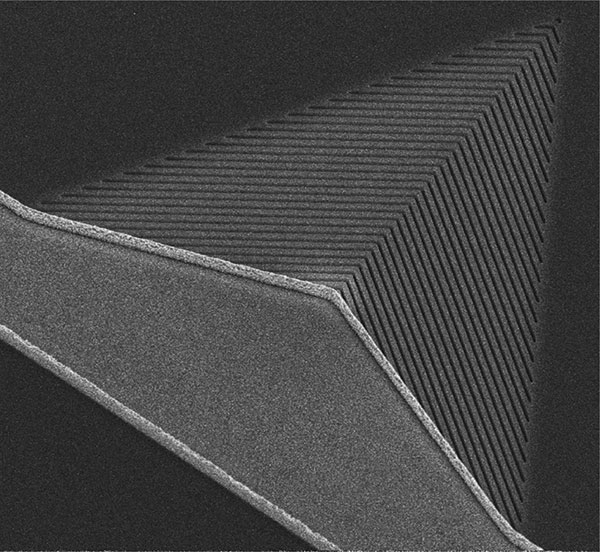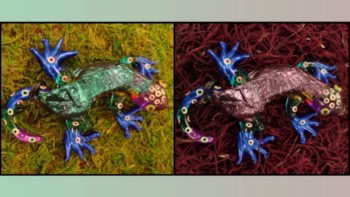Tales of invisible people and magical invisibility-bestowing objects have thrilled us for millennia. Sidney Perkowitz reveals how these myths and fantasies are now becoming a reality
If you remember your Greek mythology, you will recall that Athena, daughter of Zeus and goddess of battle and wisdom, was an extremely potent being. But even she sometimes had to behave prudently. So, in the Iliad, when she intervened on the Greek side in the Trojan War, she donned the Cap of Invisibility to conceal herself from her combative half-brother, the god Ares, who favoured the Trojans.
The seductive power of invisibility to conceal what needs to be hidden is an old fantasy, but this dream is now becoming real through technology. Novel methods are being developed to control visible light and electromagnetic waves in general – for instance, the use of artificial structures called metamaterials. The resulting “invisibility science” offers the possibility of true invisibility under visible light, as has already been nearly achieved for radar wavelengths using stealth technology. But it has also led to some unexpected outcomes such as vastly improved optical lenses, while related research offers further possible applications in controlling seismic, sound and ocean waves.
For good or evil
Despite the hi-tech nature of today’s invisibility science, it is remarkable that speculative writing and fantasy have foreseen some of its methods, even if the new science brings its own surprises. Fantasy also shows that invisibility can be a bad thing, as was understood long ago. In Plato’s Republic, written in around 380 BC, Glaucon tells how the shepherd Gyges, made invisible by a magic ring, seduces the king’s wife and murders the king – illustrating that a fear of being discovered and punished is the basis of moral behaviour. If people could turn invisible, says Glaucon, “No man would keep his hands off what was not his own…[a man could] go into houses and lie with any one at his pleasure, or kill…whom he would, and in all respects be like a god among men.”
That tinge of wickedness appears in later tales as well. Millennia after the story of Gyges, in Richard Wagner’s 19th-century The Ring of the Nibelung, the grotesque dwarf Alberich dreams of world domination using a ring of power fashioned from Rhine gold along with the Tarnhelm, a magical helmet of invisibility. This is echoed in J R R Tolkien’s 20th-century classic The Lord of the Rings when Gollum, another grotesque creature, is corrupted by a magic ring of power that bestows invisibility. One exception to the dark side, however, is the young wizard Harry Potter, who makes virtuous use of the cloak of invisibility he receives in the first book in J K Rowling’s series, Harry Potter and the Philosopher’s Stone (1997).

You might think that fictional invisibility produced by “science”, not magic, is less harmful, but that is not necessarily the case. In the late 19th century scientific invisibility became a literary theme in The Crystal Man (1881) by Edward Page Mitchell, The Invisible Man (1897) by H G Wells and The Shadow and the Flash (1903) by Jack London. Researchers in these stories anticipate great benefits as they seek invisibility in the laboratory. Eventually, however, delusions of grandeur and unforeseen consequences bring each of them to a bad end. On the other hand, the “cloaking device” introduced in Star Trek’s first television season (1966) does not provide personal invisibility, but is the ultimate camouflage for the Warbird spaceships of the Romulan Empire.
These fictional methods all make some scientific sense. Griffin, Wells’ Invisible Man, says “Either a body absorbs light or it reflects or refracts it, or does all these things. If it neither reflects nor refracts nor absorbs light, it cannot of itself be visible.” Scientific methods make Griffin, and Stephen Flack of The Crystal Man, transparent with a bodily refractive index matching that of air. Both of them become “in the air like a jellyfish in the water. Almost perfectly transparent…”, as Flack describes it. In a different approach, chemist Lloyd Inwood of The Shadow and the Flash, who is the dark Shadow in opposition to the invisibly transparent Flash, is coated with a pigment that absorbs all light, and becomes invisible except for casting a shadow and obscuring objects behind him.
In Star Trek, however, the Romulan cloaking device relies on a different principle, which is actually the same one that is used for the deflector shields that protect spacecraft such as the USS Enterprise from enemy phaser beams. The shields use gravitons – the hypothetical elementary particles that carry gravity – which, in Einstein’s general relativity, arise from the shape of space–time. This suggests that the shields and cloaking devices both work by distorting space–time to divert phaser and light beams around a spacecraft. A similar approach works in the real world, but not by applying general relativity. Rather, light is made to curve around an object by means of artificial metamaterial structures.
Under the radar
Although metamaterials are products of advanced technology, the roots of invisibility have a simpler origin: when armies abandoned gaudy uniforms such as those that the British Redcoats wore. For example, British troops in India adopted the earth-tone khaki in 1848. Later that century the US artist Abbott Handerson Thayer became the “father of camouflage” when he distinguished two strategies for protective colouration in animals: blending, where the subject is indistinguishable from the background; and disruption, where “strong arbitrary patterns of colour” break up the subject’s outline. Thayer’s ideas came into their own in the First World War and camouflage has been used in every conflict since, from uniforms that merge soldiers into the background to bold “dazzle” patterns that made warships more difficult to target. But it took modern air warfare to inspire something nearer to true invisibility, though it works under illumination by radar rather than visible light.
This “stealth” technology for warplanes is possible because a radar installation works like a lighthouse, except that it sweeps around a beam of short-wavelength radio waves. Encountering an aircraft, the beam is partly absorbed and partly reflected or scattered in various directions. What returns to the origin is detected and analysed to locate the target. Warplanes are innately visible to radar because of their reflective metal construction and protruding parts. Indeed, the US Air Force B-52 Stratofortress bomber, which was used during the Cold War, had such a huge radar cross-section of 125 m2 that it was picturesquely described as the “side of a barn”. As shown dramatically in the film Dr. Strangelove (1964), the classic dark comedy about nuclear war, a B-52 would have had to fly dangerously low to avoid enemy radar.
An aircraft’s radar image can, however, be reduced by shaping the craft to minimize scattering back along the incoming beam. Scattering calculations have been carried out since James Clerk Maxwell derived his seminal electromagnetic equations in the mid 19th century, but it was not until the 1960s that the Soviet scientist Pyotr Ufimtsev developed methods to determine scattering from complex geometries.
In 1975 engineers at Lockheed Aircraft’s Advanced Development Projects used this approach to design the F-117 Nighthawk stealth fighter. First flown in 1981, it had a strange, sharply faceted shape like a Cubist painting or a cut diamond. The design produced a minute radar cross-section of 0.02 m2, but seemed so utterly non-aerodynamic that the prototype was called the Hopeless Diamond. The F-117 proved inherently unstable in flight and was prevented from crashing only by using computers to constantly adjust its control surfaces to counteract destabilizing forces. This “fly-by-wire” approach is still essential for newer stealth aircraft such as the F-22 Raptor, first flown in 2005.

The F-117’s tiny cross-section also owes something to absorptive invisibility, such as in The Shadow and the Flash: stealth aircraft are coated with radar-absorbing material to reduce scattering. Unfortunately, the absorbed energy slightly heats the aircraft, thus increasing its infrared emission and making it more vulnerable to missiles – a reminder that invisibility in one part of the spectrum is no guarantee of invisibility at other wavelengths. Still, stealth technology is a great success. Exact figures are hard to come by, but it is said that the latest stealth aircraft have radar cross-sections ranging in size from a golf ball to a large insect, making them hard to distinguish from “blips” generated by small natural sources or electronic noise. This technology continues to develop, as shown in news reports that stealth helicopters, a previously unknown part of the US military arsenal, were used in the recent raid on Osama bin Laden’s compound in Pakistan.
Going retro
Another approach from those early stories – perfect transparency – seems unlikely to ever be achieved for people and things. But in 2003 a team led by Susumu Tachi, who was than at the University of Tokyo, produced a kind of virtual transparency called retroreflective projection technology, or optical camouflage. It came about in response to a problem found in virtual-reality applications that combine real environments with virtual or computer-generated ones. In such cases, the virtual image is projected from the viewpoint of the observer onto a real scene. The difficulty comes if a projected image, such as distant mountains, encounters a real object, say a wall. The mountains should appear to loom up behind the wall, but the projected image instead falls on the front of the wall, thus disrupting one of the many depth cues that make a scene look authentic.
In considering this depth-cue problem, Tachi’s group came up with a way to make a real, solid object appear transparent so that what lies behind it can apparently be seen through the object. The first step is to make the real object reflect incoming light back out towards the source, or “retroreflect”. This is what makes cats’ eyes glow eerily in car headlights, and it can be achieved by applying paint or material containing small glass beads. Then a camera records what lies behind the object and that image is projected off a partially transmitting mirror onto the object. A viewer looking through the mirror, if properly placed, sees the real object with the image of what lies behind the object superimposed on the object.
The result is a striking illusion of transparency, as shown in videos from Tachi’s group. Busy street scenes seem to be visible right through models wearing retroreflective jackets and cloaks. News coverage at the time hailed Tachi as the inventor of true invisibility, but the illusion is imperfect, since the background image is slightly dimmed and the garment’s outline is visible. More seriously, the optical equipment must be set up in advance and the observer fixed in the correct location, looking through the mirror, otherwise the illusion fails. Still, a 2007 report for the Canadian military notes that optical camouflage could hide a tank, say, by making it effectively transparent, though that would work only for a parked tank when viewed from a particular location.
Tachi’s group, now at Keio University, has also developed the “transparent cockpit” to give drivers a full view of a vehicle’s surroundings. External cameras on the vehicle send images to a computer. The driver wears a projector that sends the images, altered as if seen from the driver’s position, onto retroreflective coatings on the car’s interior surfaces. An arresting demonstration from Tachi’s group shows adjacent traffic apparently seen right through an automobile’s dashboard and door. Better yet, the inventors imagine a helicopter pilot gazing through a transparent cockpit as if soaring along in thin air – a real-life Invisible Plane as used by comic-book superhero Wonder Woman.
To invisibility…
The most stunning form of true invisibility, however, is much more elegant: light is bent to travel around an object rather than interact with it, emulating Star Trek’s cloaking device. Like water in a stream splitting around a rock and rejoining into a smooth flow downstream, light rays divert around the object, then recombine and continue on as if they had never been disturbed.
Like water in a stream splitting around a rock and rejoining into a smooth flow downstream, light rays divert around the object, then recombine and continue on as if they had never been disturbed
This came from an old idea. In 1964 Victor Veselago of the Lebedev Physical Institute in Moscow theorized about electromagnetic waves in a medium with an unheard-of property: a negative refractive index. The refractive index, n, is the ratio of the speed of light in vacuum, c, to its speed in the medium. This is always less than c, so n is greater than 1 in all known media. But Veselago found that n would be negative if a medium’s permittivity, ε, and permeability, μ, which determine its electric and magnetic responses, respectively, were both negative.
Such a medium, he predicted, would refract light in an opposite-to-usual direction, so a concave lens would focus light rays and a convex lens would diverge them; the medium would be pulled towards a light source instead of being pushed away by radiation pressure; and it would support an inverted Doppler effect, with light becoming blue-shifted rather than red-shifted as a source moves away from an observer.
The theory remained untested until 2000, when researchers at the University of California, San Diego, built a metamaterial that met Veselago’s criteria. It was made of hundreds of millimetre-sized units arranged in a repeating pattern, like atoms in a crystal. There were two types of units: copper strips, where a large complement of electrons acted to generate ε < 0; and copper C-shaped split-ring resonators, in which currents induced by the incoming light produced magnetic effects that gave μ < 0. At a microwave wavelength of 3 cm, the metamaterial yielded n = – 2.7 and displayed backwards refraction.
This showed how to create values of n not found in nature and, in turn, how to make things invisible. In 2006 the theory of cloaking was published simultaneously by Ulf Leonhardt of the University of St Andrews and by John Pendry of Imperial College London with David Smith and David Schurig of Duke University in the US. The latter group calculated the refractive profile of a hollow spherical shell that would intercept incoming light rays, bend them into the shell and through it, then refract them back out along continuations of their original paths. The required refractive index varied within the shell, in some places taking on exotic values of less than 1 or even less than zero.

The same year, Smith’s group at Duke including Schurig, along with Pendry and others, used this theory to build the first metamaterial cloak. Its 10 concentric rings, 5.4–11.8 cm in diameter, contained thousands of copper split-ring resonators with dimensions that varied across the rings to give the correct spatial behaviour for n. Uncloaked, a 5 cm-wide copper cylinder strongly scattered 3.5 cm microwaves and cast a shadow; but when the object was placed within the cloak’s central opening, its scattering and shadowing were reduced to almost nothing. Images of the microwaves show that they entered the cloak, split so as to bypass its central opening, and recombined to emerge from the opposite side in the same conformation as when they entered, just as calculated.
Unsurprisingly, this success attracted vast public interest, aided by hyped headlines such as “Harry Potter invisibility cloak ‘within five years’ ”. Scientific interest ran high too, and researchers have now cited this work some 800 times. Such intense activity raises the prospect of us overcoming the considerable barriers to achieving invisibility for the visible wavelengths of 400–750 nm. One challenge is that metals such as copper are highly absorbing there, so the cloak itself would cast a shadow. Another is that the metamaterial elements need to be smaller than the wavelength, which for visible light means nanostructures rather than the millimetre-scale elements in the microwave experiments. A third issue is that split-ring resonators give μ < 0 only at specific wavelengths. This is another reason why it has been difficult to make objects invisible across the electromagnetic spectrum, including its visible portion.
One breakthrough in optical invisibility, however, is the “carpet cloak” invented by John Pendry and Jensen Li in 2008 – a metamaterial that needs only a spatially varying n, without resonator rings, to make a bump on a surface appear flat, therefore hiding an object beneath. In 2009 carpet cloaking was demonstrated with microwaves and also for near-visible infrared light of around 1500 nm, but only for microscopic objects. In late 2010 two different groups presented another approach. Almost simultaneously, they reported the achievement of invisibility for millimetre- to centimetre-sized objects over the visible range from red to blue. Remarkably, these results did not require complex metamaterials, using instead the anisotropic optical properties of the naturally occurring crystal calcite to produce a form of carpet cloaking.
…and beyond!
True invisibility science is only five years old. But now that scientists know that invisibility is possible, they are moving into top gear and military applications guarantee research funding. Apart from cloaking, and regardless of whether simpler approaches such as the use of calcite develop further, metamaterials are yielding advances unforeseen in fantasy or science fiction, such as “superlenses” with resolutions far better than ordinary lenses. These improved lenses could, for the first time, make it possible to see viruses and proteins directly with visible-light microscopy. They could also lead to more effective computers, because the number of devices that can be packed onto a computer chip is limited by the resolution of the optical system that lays it out. Other possibilities include using acoustic superlenses to improve medical ultrasound scanning, and using metamaterial-like principles to make buildings “invisible” to destructive seismic or ocean waves.

There is another route as well to human invisibility – a garment that goes beyond Tachi’s retroreflective projection technology. This true invisibility cloak would collect a real-time image from sensors on its back and project that image from devices on its front. The cloak would seem transparent even as it or an observer moves. In 2002 Franco Zambonelli and Marco Mamei of the University of Modena and Reggio Emilia in Italy proposed that a cloak densely covered with light detectors and emitters 5 μm across, wirelessly interlinked at terabyte rates, could dynamically maintain a convincing illusion that it is not there. They suggested that the cloak’s movements could power the network via piezoelectric devices that convert mechanical strain into voltage, although power could even come from the wearer’s own body heat. Such a cloak with an area of 3 m2 would cost less than €500,000, they suggested, and while we do not yet have devices of the requisite size and capability, one hope lies in the small light detectors and emitters made from the nanometre-scale semiconducting units called quantum dots. These can be formed in large arrays, and one method tailor-made to produce a cloak has already been successfully tested: putting the dots in solution and spraying them onto cloth through an inkjet printer.
The goddess Athena, the Invisible Man and other mythological and fantasy characters could not have imagined an assembly line of inkjet printers spraying invisibility technology onto cloth; anyone familiar, however, with the “chameleon” camouflage suits of military science fiction – such as those worn by the 25th-century Space Marines portrayed in the Star Fist series by David Sherman and Dan Cragg – would not be surprised. And if, as seems inevitable, the price of a mass-produced invisibility cloak were eventually to drop from €500,000 to, say, €19.95, we would finally have to face the question that Glaucon posed so long ago: if questionable acts became widely undetectable, could morality survive?
- This article first appeared in the July 2011 issue of Physics World. Since then a 3D invisibility device that uses lenses and works for different angles of view has been created.



